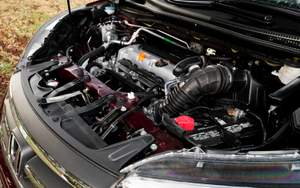
[Ed note: The 2013 Honda CR-V is #10 among our Top 10 most fuel efficient SUV/AWD vehicles for 2013]
When Honda introduced the CR-V in 1997, gasoline was around $1.25 per gallon and the little runabout’s fuel economy of 19 mpg city/ 21 mpg highway didn’t play a big role in people’s choice of the vehicle.
Today [ed. note: July 2013], the national average for a gallon of gas is $3.54, according to AAA, and fuel economy is now at, or near the top of the list for many new car buyers.
Fuel economy is most certainly a contributing factor in the 2013 CR-V’s 145,000-plus sales through June. Honda’s smallest sport utility (crossover, if you prefer, since it rides on a car-based platform) tops the elusive 30-mpg highway barrier, with 23 city/31 highway. The all-wheel drive versions are rated at 22/30.
That’s quite remarkable when you consider the first edition’s 2.0-liter four-cylinder engine produced 126 horsepower and the 2013 model employs a larger 2.4-liter four that puts out 185 horsepower.
The CR-V was completely redesigned in 2012 with new sheet metal and cabin design, more standard features and an updated powertrain with improved fuel economy. Like the original, this CR-V is based on the same structure as the Honda Civic compact car.
This fourth-generation CR-V is handsomely aerodynamic, sophisticated and nicely proportioned. The front features a three-bar grille and large multi-reflector halogen headlights that are deeply set into the fenders.
Large wheels and bold fender wells combine with sculpted side body panels give a pseudo-aggressive look. In profile, the sweeping roofline has an almost coupe-like appearance.
Backside, the CR-V’s signature vertical taillights are larger than the previous model, with the base extending into the rear body panels in a hockey stick style. The tops of the lights merge with the rear spoiler helping to improve aerodynamic drag.
Inside, the airy passenger compartment is pleasantly laid out, with ergonomically sound controls, clear instrumentation, and solid, upscale materials. The navigation system doesn’t always understand spoken commands, but you’ll never tire of the precision and tactile rewards built into every knob and button.
Front seats are well shaped and supportive. The standard tilt/telescoping steering column and height adjustable driver’s seat assists drivers of all sizes in finding a comfortable position. Honda again has mounted the transmission shift lever on the lower part of the dashboard near the driver’s knee, freeing up space for a large center console.

Second row seating provides enough head, shoulder and legroom to comfortably seat two adults for an all-day drive. In case your passengers happen to be toddlers rather that adults, fitting all forms of car seats is a breeze.
Behind the second row there’s 37.2 cubic feet of cargo space. A clever mechanism folds the rear seat even with the rear load floor at the pull of a single lever or strap, expanding cargo volume to 70.9 cubic feet – more space than you’ll find in most affordable compact SUVs.
To be competitive, standard on all trim levels includes remote keyless entry; power locks, windows and outside mirrors; cruise control; air conditioning; and an AM/FM/CD audio system. One standard feature of particular note is a rearview backup camera.
Honda brings the latest CR-V closer to the class leaders for basic infotainment features by finally installing as standard on every model such modern necessities as Bluetooth hands-free phone connection, music streaming and a USB iPod interface.
Like others in the class, available options incude leather upholstery, an upgraded audio system and a navigation system. Unusual for small sport utilities, Honda offers a rear DVD entertainment system. However, it is not available if you want the navigation system.
With the CR-V, Honda turns a little package into a lot of fun in a back-to-basics sort of way. It feels nimble and light on its feet and when it comes to ride and handling, the CR-V doesn’t stray far from its Civic roots. The four-wheel independent suspension — MacPherson struts up front, multi-link in rear — enables the tires to keep in close contact with the pavement. As such, it feels stable when rounding curves and turning corners. And, the suspension soaks up most examples of bad pavement with minimal disruption to occupant comfort.
The drivetrain will be familiar to the Honda faithful. Power is derived from a dual-overhead cam in-line four-cylinder engine that features Honda’s i-VETEC “intelligent” valve control system. Horsepower output of 185 is

among the leaders in its competitive set but torque of 185 pounds feet is below average. Torque – the force that gets the vehicle moving – is more important to the feel of acceleration than horsepower – the energy that keeps the vehicle moving.
Our CR-V test driver had enough power on hand to dash through traffic and cruise along with fast-moving traffic. Where it came up short was on long grades with a full load of passengers and luggage. The engine had to spin along in full song and the five-speed automatic transmission needed to hang on to a low gear to keep up with traffic.
Like most of its competitors, the all-wheel drive system is not suited for serious off-road use. But Honda’s Real Time AWD with Intelligent Control System not only instantaneously shuffles power between the front and rear axles to benefit traction on both wet, snow and dry surfaces, it is quite capable on gravel or dirt trails.
Also, the CR-V has a 1,500-pound tow rating. So, if you want to pull a small tent trailer or haul a couple of ATVs or snowmobiles to your favorite out-of-the-way place, the CR-V is up to the task.
While small in size, the CR-V has all the safety biggies: six airbags, four-wheel anti-lock disc brakes, traction control and stability control. The Insurance Institute for Highway Safety (IIHS) has named the CR-V a “2013 Top Safety Pick.”
Competitive pricing is a must in the compact sport utility segment and the CR-V starts at $27,795 plus $830 destination charges for the base LX front drive, $24,045 the AWD version. Following Honda practice, the CR-V doesn’t offer options per se, coming instead in well-defined trim levels that increase features as they climb the price ladder. Front drive versions can top off at $29.045, AWD at $30,295.
On a day-to-day basis the Honda CR-V will perform its driving duties admirably, offering affordable commuting as well as providing space for kids, gear and pets.
Other related stories you might want to check out:
Top 10 2014/2013 AWD & 4WD SUVs/Crossovers
Better Fuel Economy Front & Center at the NY Auto Show
All-Wheel-Drive Cars and SUVs with Best Mileage
